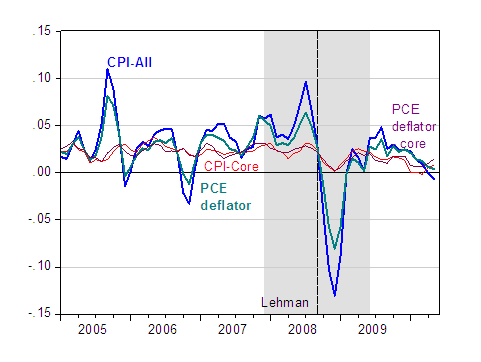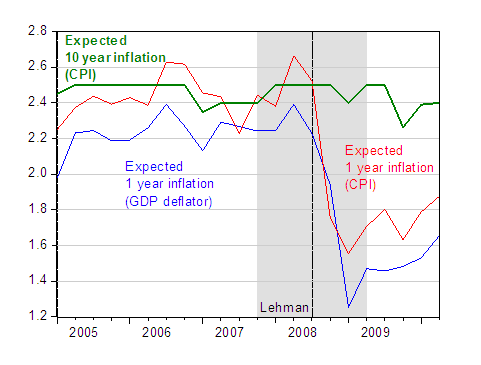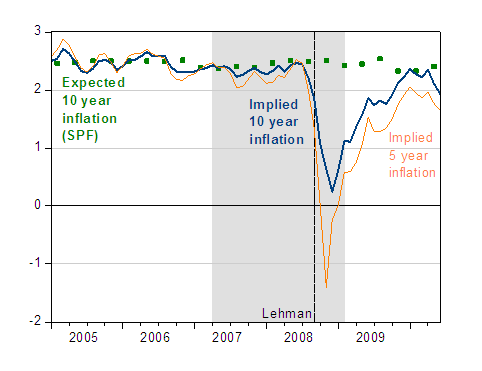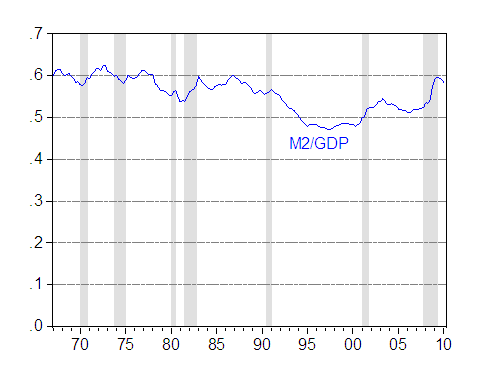Given concerns about large budget deficits and quantitative easing feeding into inflation even as actual inflation was falling, I wondered what standard measures indicated. This follows up on the same question I posed in May of last year.
First, here is the annualized 3 month change in price indices.

Figure 1: Annualized 3 month growth rate of CPI-All (blue bold), CPI-Core (red), Personal Consumption Excpenditure (PCE) chain-index (teal bold), PCE-Core (lavender). Gray shaded area denotes recession dates, assuming trough at June 2009. Source: BLS and BEA via FREDII, NBER, author’s calculations.
The trend looks downward to me.
What about expectations? From the Survey of Profession Forecasters:

Figure 2: One year expected GDP deflator inflation (blue), one year expected CPI inflation (red), and ten year expected inflation (bold green). Observations pertain to mid-quarter month. Gray shaded area denotes recession dates, assuming trough at 2009Q2. Source: Philadelphia Fed Survey of Professional Forecasters.
Little evidence of a surge here.
Strangely, there are many skeptics of economists who read this weblog, so I will also appeal to market based measures of inflation expectations. In the graph below, I plot the 10 year expected inflation from Figure 2, as well as the 10 year Treasury-TIPS and 5 year-TIPS spreads.

Figure 3: ten year expected inflation (green squares), ten year implied inflation from 10 year Treasury-TIPS spreads (dark blue bold line), and five year inflation from 5 year Treasry-TIPS spreads. Gray shaded area denotes recession dates, assuming trough at 2009Q2. Source: Philadelphia Fed Survey of Professional Forecasters, and FREDII.
In sum, it is hard to see why so many individuals are in mortal fear of incipient inflation (e.g., [2])For those who believe in the Phillips curve, there is even less reason to believe a surge in inflation is just around the corner, given the massive (negative) output gap [3].
Update: 8 July, 6:15am Pacific: Reader CP admonishes me to look at money supply, and cites a change in a nominal dollars. I prefer to look at M2/GDP, i.e., inverse velocity in the quantity identity.

Figure 4: End-of-quarter M2, seasonally adjusted, divided by nominal GDP. Source: Fed via FREDII, and BEA, 2010Q1 3rd release, NBER, and author’s calculations.
I still don’t see hyperinflation…
Inflation swaps are another market-based measure of inflation expectations, and they are available nearly real-time from Bloomberg.
The 5-year inflation swap, for instance.
Obviously modest near term inflation, two or three percent next month or next year, is unlikely.
Immodest inflation, hyperinflation in 2016, 2020, is rather likely. And to the extent that one expect 1000% inflation, one is not going to buy TIPS. One is going to buy gold. And what the gold market says is that there is a significant likelihood that in the not very distant future, the only use for hundred dollar bills will be as wrapping paper.
Menzie I agree with you assessment the market is not pricing in any inflation in fact it agrees with Ben, deflation is the short term view, QE had no further stimulatory effects after the initial impact and thus deflation remains at the forefront of minds. I disagree with that on two levels: (1) Take inflation back to roots…What has been the cause of deflation for the last decade. Answer China. What is happening in China? Wage inflation, strengthening of RMB, house price bubble…Can only see prices increasing.
Given my Chinese argument ask the US if you can experience inflation with a large output gap. Check out CPI 1975-79 given the appreciation in Yen, its definitely possible.
(2) As David Rosenberg so nicely puts it ‘The U.S. turned 234 years old yesterday, and yet over half of the nations money supply was created since Helicopter Ben took over the flight controls four years ago.’Menzie I agree with you assessment the market is not pricing in any inflation in fact it agrees with Ben, deflation is the short term view, QE had no further stimulatory effects after the initial impact and thus deflation remains at the forefront of minds. I disagree with that on two levels: (1) Take inflataion back to roots…What has been the cause of deflation for the last decade. Answer China. What is happening in China? Wage inflation, strengthening of RMB, house price bubble…Can only see prices increasing.
Given my Chinese argument ask the US if you can experience inflation with a large output gap. Check out CPI 1975-79 given the appreciation in Yen, its definitely possible.
(2) As David Rosenberg so nicely puts it The U.S. turned 234 years old yesterday, and yet over half of the nations money supply was created since Helicopter Ben took over the flight controls four years ago. No wonder gold is in a full fledged bull market . . .
Watch Money supply……
Dr. Chinn-
These standard measures provide significant evidence of muted inflation expectations. Indeed technological innovation and labor oversupply help keep corporate costs down.
However, if not inflation and fear of inflation, how can one explain the price of gold? If gold is a commodity, than it is clearly a bubble. If it is a currency, as “old school” economists insist, then it has certainly surged against its fiat counterparts. In any case there is a lot of speculators in the volatile gold market. Yet goldbugs and mainstream monetary policy wonks alike must agree that fear of hyperinflation(among far worse scenarios) is driving at least part of the gold price runup.
How can one empirically measure the link between safe haven buying of gold, and inflation expectations?
I’m keen to hear your thoughts on this.
Jacob Mohs: See Laurence Blose, as well Jim’s post on the subject.
If the worry is hyperinflation, then how does one get there? The markets aren’t pricing it in for US treasuries and gold’s price clearly reflects safe haven pricing, not inflation worries. For inflation to take off and run away, there needs to be a mechanism by which it is transmitted. What would that be? A sudden shift away from the dollar? That’s the only big one and it was talked about 3-4-5 years ago as a possibility and yet we’ve seen a shift toward the dollar and maybe, just maybe a hint that we might see some movement over time toward some other instrument -though what remains unclear. The Chinese talk about World Bank instruments, not the RMB, and the Euro is no longer a reserve option.
In other words, continuing my quest to request that you focus on the idiotic arguments people actually advance, take apart the lack of mechanism that hyper-inflation requires. There seems to be a strange idea that it magically appears from nowhere but it actually depends.
I veiw short term deflation as a price correction. Deflation is only a problem is it is long term.
It’s also relative. If growth is 1%, 3% inflation is runaway inflation.
Here’s another thought on why companies and people aren’t investing, maybe we need a little deflation. I think the right word is actually price correction.
Short term rates show expectations of deflation, but long term rates show inflation (I don’t think the additional time justifies such a high risk premium for long term debt). I think people and companies holding on to cash because the aren’t seeing the price corrections they need.
I don’t think we should fear deflation, not in the short term. Deflation is only a problem when it become a long term expectation, as it becomes when it is expected but doesn’t show up.
Inflation is deader than Jimmy Hoffa. Inflation? With declining unit labor costs? With a de-unionized private labor force? With global competition in all goods? With extremely soft commercial rents (fun stat: Rent in downtown Los Angeles, for nice office space, is the same today as the late 1970s–about $3 a sf per month).
Together, if memory serves, labor and rents make up about 70 percent of business costs–and they are both going down, not up.
MZM (St. Louis Fed measure of money supply) is down from a year ago.
Commodities, despite becoming a speculative market in recent years, are down on the year.
Gold? Gold is for morons. And is has little to do with the US anymore. The heavy buyers of gold are China and India–people with newly disposable income. The Fed has nothing to do with gold anymore. China has expanded its money supply by 20+ percent in the last year, and their economy is growing nearly at double digits–they are heavy buyers of gold, and the price goes up. What has this to do with the US?
Really, the Inflation Cassandra crowd reminds me of the worst elements of the Global Warming crowd–hysterical projections from scant real evidence.
My advice to the Fed: Pour it on, quantitatively, qualitatively, and any other way possible. Blow the doors off, print money until the plates melt.
Really, we should run a national lottery, that pays out $10 ex nihilo for every dollar it takes in. Get a mania going.
I would orefer a long inflationary boom to a long deflationary recession. I get the strange feeling many would prefer the latter. You know, suffering is good.
I find it particularly difficult to see how hyperinflation is about to break out when wages are stuck in a deflationary mode. I think, on balance, we are seeing many more deflationary tendencies than inflationary ones.
Frankly, I think given the high nominal debt burdens still hanging over consumers we could use a little wage inflation to assist in the deleveraging. I fail to see how persistent wage stagnation is of a great assistance in helping to reduce debt burdens.
@CP:
Yes, inflation is possible with an output gap, but that generally only occurs when the shortfall is on the supply side. That is, in Keynesian terms, when intended savings falls short of intended investment.
In Keynes’s time, the problem was the opposite, so there was less focus on the policy implications of this type of shortfall, but those who haven’t read Keynes general theory often are ignorant of it’s full implications, amongst them is that the appropriate Keynesian policy for the 1960s-1970s was cuts in government spending, which unfortunately did not occur.
The key there is, it is possible to have excess demand for currently available goods and services, but no way to quickly increase output due to high levels of capacity utilization. You can still have employable labor freely available, but lack the capital assets needed to employ them productively. Take a look at capacity utilization rates in the 1960s and 1970s:
http://research.stlouisfed.org/fred2/series/TCU?cid=3
I don’t see us getting inflationary pressures without utilization rates getting back up to near 85%. China is an emerging and rapidly industrial economy which will still see capacity shortfalls, and the need for capital investment.
But right now, with no shortage of capacity, no shortage of qualified labor, no shortage of money (with corporations sitting on $1.8T cash and banks on $1T in excess reserves), where exactly is the shortfall, in the US, Europe, and globally, if not on the demand side?
On gold, high gold prices are just one more indication of an excess of intended savings over intended investment. In a healthy growing economy, with inflation, investors would not want to hold unproductive assets like gold. You would do better holding productive assets, as the value of future goods produced would be inflation protected.
Remember, in the early 1930s, in the face of a deflationary slump, gold went up sharply as both Britain and the US had to revalue their currencies; but you really didn’t get a problem with inflation until the 1940s, when wartime demand began to run up against industrial capacity constraints.
You simply won’t get any general inflation problem until you run up against some sort of constraints in labor or capacity. You can argue that the value of the dollar is nonetheless deflating relative to gold. But, what is the dollar backed by now that it is a fiat currency? It is backed by the entire output of the US economy. In that sense, the value of the dollar is falling because output is falling. The way to restore the value of the dollar (relative to gold) is to restore output.